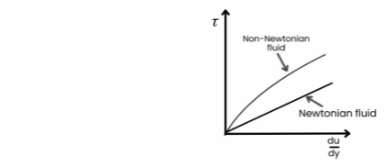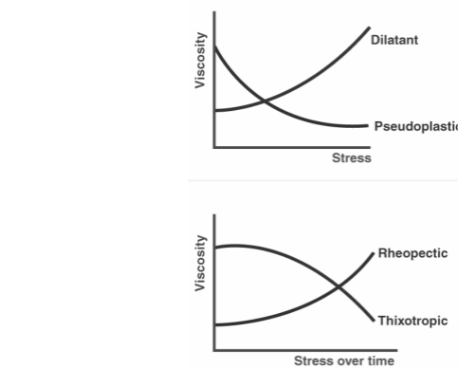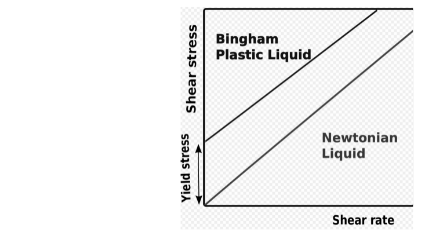If we dump a cup of water onto an inclined surface beside a cup of honey, the water will definitely flow faster than the honey. This happens as a result of the fluid’s viscosity attribute.
A Newtonian fluid is one in which the viscous stresses generated by its flow are linearly proportional to the local strain rate, or the rate at which its deformation changes over time, at every place. The rate of change of the fluid’s velocity vector determines the stress.
Only if the tensors that characterise viscous stress and strain rate are coupled by a constant viscosity tensor that is independent of stress state and velocity of the flow is a fluid Newtonian. The viscosity tensor is reduced to two real coefficients describing the fluid’s resistance to continuous shear deformation and continuous compression or expansion, respectively, when the fluid is also isotropic.
Newtonian fluids are the most basic viscosity-accounting mathematical models of fluids. While no real fluid exactly meets the criterion, many common liquids and gases, such as water and air, can be assumed to be Newtonian in practical calculations under normal circumstances.
Statement of Newton’s law of viscosity
According to Newton’s viscosity law,
The velocity gradient is directly proportional to the shear stress. The negative value of the velocity gradient between the same two adjacent layers of the fluid is directly proportional to the shear stress between the same two adjacent layers of the fluid.
It’s represented as:-

Where μ is the proportionality constant known as dynamic viscosity, with the unit N.s.m-2.
Types of Fluids
Based on Newton’s law of viscosity, there are two types of fluids:
- Newtonian fluids
- Non-Newtonian fluids
Newtonian Fluids

The Newtonian fluid is defined as a fluid whose viscosity remains constant. The amount of shear stress applied to these fluids has little effect on their behaviour over time. These fluids have a linear connection between viscosity and shear stress.
For e.g. Mineral oil, water, alcohol, gasoline.
Non-Newtonian Fluids
Non-Newtonian fluids are defined as fluids whose viscosity changes when shear stress is applied. Newtonian fluids are the polar opposite of these fluids.
For e.g. Cosmetics, paint, ketchup, toothpaste.
Types of non-Newtonian Fluids
Non-Newtonian fluids are divided into four categories:
- Dilatant: When shear force is applied to these fluids, their viscosity increases. Dilatant fluids include quicksand, cornflour with water, and putty.
- Pseudoplastic: When shear force is applied to certain fluids, their viscosity drops. Dilatant fluids are the polar opposite of these fluids. Pseudoplastic foods include ketchup.
- Rheopectic: When shear stress is applied over time, the viscosity of these fluids increases. These fluids are comparable to dilatant fluids, however they are time-dependent. Rheopectic fluids include things like cream and gypsum paste.
Thixotropic: When shear force is applied over time, the viscosity of these fluids reduces. Thixotropic fluids include cosmetics and paint.

Non-Newtonian fluids can also be classified according to their shear stress or shear rate behaviour:
- Fluids whose shear stress varies with the passage of time
- Fluids with a shear stress that is independent of time
Bingham bodies

A viscoplastic substance known as a Bingham plastic behaves like a stiff body under low stress but flows like a viscous fluid under high load. Eugene C. Bingham proposed the mathematical form, which is why it is named after him. In drilling engineering and slurries handling, it’s a standard mathematical model of mud movement.
Conclusion
The flow resistance of simple fluids is defined by the physical property of viscosity. Newton’s law of viscosity describes the relationship between shear stress and shear rate in a fluid exposed to mechanical stress. The viscosity or coefficient of viscosity is a constant for a given temperature and pressure and is defined as the ratio of shear stress to shear rate. Newtonian fluids follow Newton’s viscosity law. The shear rate has no effect on the viscosity.
Because non-Newtonian fluids do not obey Newton’s law, their viscosity (the ratio of shear stress to shear rate) is variable and depends on the shear rate. Newton’s law of viscosity defines dynamic viscosity as the coefficient of viscosity. By dividing the dynamic viscosity by the density, the kinematic viscosity may be computed.
 Profile
Profile Settings
Settings Refer your friends
Refer your friends Sign out
Sign out






